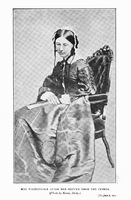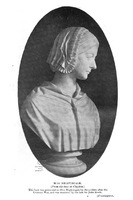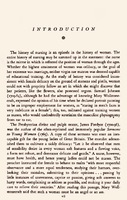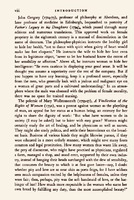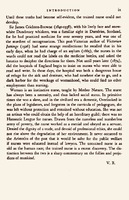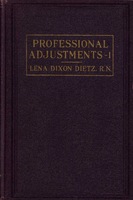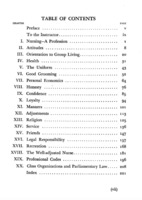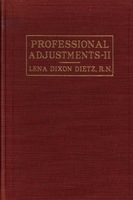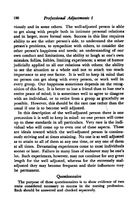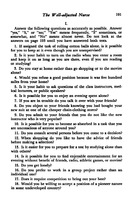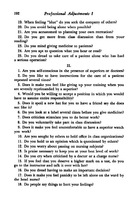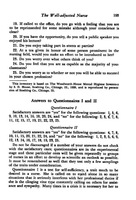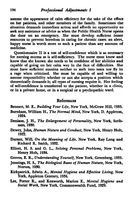Nurse Stereotypes and Archetypes
The "Nightingale Effect"
Persistent stereotypes about nurses are contradictory: angelic, virginal, and self-sacrificing portrayals are as common as those that depict the nurse as aggressive, condescending, or overly sexed. These stereotypes get reiterated with various archetypes: the handmaiden, the martyr, the angel, the flirt, the bawd, or the villain.
The history of nurse stereotypes can be traced, in part, to the history of the profession and nurse training. Florence Nightingale is often credited for igniting the movement that transformed nursing into “respectable paid labor” for women of the middle and upper classes. Victorian ideas of femininity and the ideal woman advocated separate spheres for women and men and Nightingale carefully described the traits of a nurse to align perfectly within these beliefs. In doing so, she limited the emerging occupation of nursing to women, but also applied strict Victorian conventions to the practice of nursing.
Since then, the profession has been linked to each era's notions of the ideal woman; in this way, fictional portryals of nurses express tensions and anxieties about women's agency and autonomy. The movement to make nursing an acceptable occupation for women also required concessions in regards to the functions and authority of nurses. The profession of nursing conceded some agency to medical hierarchies, which placed doctors—men—in power. In some ways, professionalization made women's organizing for legal and social equality more difficult as it exaggerated the differences between women of different educational background and economic classes.
Through the early and mid-twentieth century, training programs for nurses spent a great deal of time on the professional socialization of students. This process, which emphasized the proper demeanor, manners, and subordination of the nurse contributed to many of the stereotypes that persist today.
Professional Socialization: Ethics and Professional Adjustments
Professional socialization of student nurses was carried out in both formal courses and informally during their clinical work. Nurses took classes called "ethics" that taught etiquette, manners, and habits more than accuracy, charting, or procedures for reporting concerns and issues. Professional socialization of nursing students contributed to the practices, attitudes, and behaviors associated with many of the common nurse stereotypes.
Changing the curriculum and hospital dynamics was a slow process through the 20th century even as professional nursing associations advocated for changes in curriculum, the creation of advanced degrees and specializations, lobbied for state's to redefine nursing, and fought for professional autonomy and recognition. Nurses today still strive to overcome steretypes in popular culture and mass media; they fight images that they find trivializaing, negative, or inappropriate. Ironically, during times of national hardship and crisis, when the importance of nursing become most clear to the public, the most prevalent images of nurses are stereotypes that emphasize emotional labor as opposed to images of nurses as highly-skilled medical professionals.
In 1937, the National League of Nursing Education revised professional development standards, with new recommendations published in A Curriculum Guide for Schools of Nursing. New trends in psychology and education emphasized "professional adjustments" over "ethics." Hospital schools and nursing baccalaureate programs adopted a two-course system meant to address the different professional adjustment needs of student nurses and graduating nurses.
Professional adjustment courses evaluated how well a nurse adopted and demonstrated specific characteristics; these indicated the student’s level of self-awareness and ability to thrive in her future career. Rather than being virtues she was born with or behaviors drilled into her in a military-like fashion, these characteristics were to be fostered over time and demonstrated the nurse’s personal and professional growth over the course of her training.
Click the image to the left to learn more professional adjustments!
13 Characteristics of a Well-Adjusted Nurse:
According to the National League of Nursing Education, there were 13 characteristics a nursing student should demonstrate by the time she graduated from her training program:
- She is healthy, mentally, and physically.
- She is mentally alert.
- She is technically competent.
- She is dependable.
- She inspires confidence.
- She is resourceful.
- She is well poised.
- She is considerate of others.
- She is cooperative.
- She is agreeable.
- She is cultured.
- She derives personal satisfaction from her work.
- She has a sense of social and professional responsibility.
Lena Dietz, author of the Professional Adjustments course texts included two questionnaires in her Professional Adjustments I book to help students assess their level of self-sufficiency and self-confidence.
Click the image to the right to see the questionnaires! Would you pass this self-assessment?
Critical Thinking Prompts
-
What is the relationship between socialization and professional development?
-
How do different social eras produce different dispositions, exepectations, regulations, and practices in the field of nursing?
-
Do the training manuals always reflect the norms of their social era? Can you find examples in which they are either behind-the-times or predictive of an upcoming change in social ideology?
-
Are there parallel representation of nursing or nurses in non-fiction works? For example, how are codes of behavior, training, or the demeanor of nurses portrayed in the romance novels as compared to nurse training manuals of the same time period?
-
Can you think of other professions that are mired in stereotypes whose origins might be related to the hitory of the profession's development and the socialization of its workers?
-
What are some recent media representations of nurses that reiterate steretypes?

